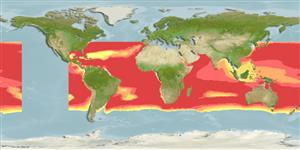>
Stomiiformes (Lightfishes and dragonfishes) >
Stomiidae (Barbeled dragonfishes) > Melanostomiinae
Etymology: Eustomias: Greek, eu = good + Greek, stoma = mouth (Ref. 45335).
Eponymy: Dr Ernst Johannes Schmidt (1877–1933) was a Danish biologist who became the Director of the Laboratoire Carlsberg (1909–1933). [...] (Ref. 128868), visit book page.
More on authors: Regan & Trewavas.
Environment: milieu / climate zone / profondeur / distribution range
Écologie
marin bathypélagique; profondeur 50 - 150 m (Ref. 58302). Deep-water; 40°N - 49°S, 98°W - 154°W
Atlantic and Pacific: between 35-40°N and 30-35°S, primarily in boundary currents or equatorial waters; generally absent from gyres.
Length at first maturity / Taille / Poids / Âge
Maturité: Lm 12.8, range 11 - 14.4 cm
Max length : 21.2 cm SL mâle / non sexé; (Ref. 4468)
Épines dorsales (Total) : 0; Rayons mous dorsaux (Total) : 22 - 28; Épines anales: 0; Rayons mous anaux: 36 - 43. Barbel with three branches arising from stem; medial branch stout, bulbous and with distal filaments barely reaching to barbel tip; lateral branches tapering, extending well beyond end of barbel (except in small specimens); terminal bulb unpigmented and elongated, occupying most of distal barbel, tightly constricted distally into spheroidal terminal section; terminal filament or single-based group of filaments arising ventrally from constriction.
Body shape (shape guide): elongated.
Epi- and mesopelagic (Ref. 58302).
Life cycle and mating behavior
Maturité | Reproduction | Frai | Œufs | Fécondité | Larves
Gibbs, R.H. and M.A. Barnett, 1990. Melanostomiidae. p. 308-337. In J.C. Quero, J.C. Hureau, C. Karrer, A. Post and L. Saldanha (eds.) Check-list of the fishes of the eastern tropical Atlantic (CLOFETA). JNICT, Lisbon; SEI, Paris; and UNESCO, Paris. Vol. 1. (Ref. 4468)
Statut dans la liste rouge de l'IUCN (Ref. 130435: Version 2025-1)
Menace pour l'homme
Harmless
Utilisations par l'homme
Pêcheries: sans intérêt
Outils
Articles particuliers
Télécharger en XML
Sources Internet
Estimates based on models
Preferred temperature (Réf.
123201): 15.7 - 27.1, mean 23.3 °C (based on 442 cells).
Phylogenetic diversity index (Réf.
82804): PD
50 = 0.5000 [Uniqueness, from 0.5 = low to 2.0 = high].
Bayesian length-weight: a=0.00302 (0.00116 - 0.00786), b=3.12 (2.89 - 3.35), in cm total length, based on LWR estimates for this (Sub)family-body shape (Ref.
93245).
Niveau trophique (Réf.
69278): 4.2 ±0.73 se; based on food items.
Résilience (Réf.
120179): Milieu, temps minimum de doublement de population : 1,4 à 4,4 années (Preliminary K or Fecundity.).
Fishing Vulnerability (Ref.
59153): Low vulnerability (16 of 100).
🛈
